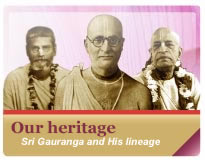by Sripad Madhava Maharaj
[Two days before Paramaradya Srila Narayana Maharaja left Mathura to embark on his winter preaching tour in the West, he brought up a controversial topic in his evening class. He spoke for some time in Hindi and asked Sripad Madhava Maharaja to convey the same ideas in English. The following is a transcription of Sripad Madhava Maharaja's talk. - ed.]
[Sripad Madhava Maharaja:] Srila Gurudeva has ordered me to speak and I will explain up to my level best.
[Srila Narayana Maharaja:] What is the question? First say the question.
[Sripad Madhava Maharaja:] Srila Jiva Gosvamipada, who is one of the six Gosvamis, has stated that the jivas are performing sadhana-bhajana here in this world. In the meantime, in the Vaikuntha planets - meaning Vaikuntha, Ayodhya, Dvaraka, Mathura and Goloka Vrndavana, there are some parsadas, associates of Bhagavan, who came from His effulgence, and they are in a latent or dormant position. When a jiva becomes perfect by performing sadhana-bhajana, he obtains any one of these parsada-dehas (bodies of these associates). This is one side. On the other side, seemingly different from Srila Jiva Gosvamipada, are Srila Visvanatha Cakravarti Thakura, Srila Bhaktivinoda Thakura, Srila Baladeva Vidyabhusana, Srila Rupa Gosvamipada, and all our acaryas up to the present day. They are saying that the jiva already has a constitutional form, his own spiritual body, along with its transcendental qualities and services, but now his spiritual body is unmanifest, or in a latent position. As the potency of an entire tree, along with its leaves, flowers, and fruits, is present in its seed, everything is present in the soul, but in seed form. In this way it appears that Srila Jiva Gosvamipada is on one side and the other acaryas, up to our present guru-varga, are on the other side. It seems that both ideas are quite opposite. How we can reconcile this apparent contradiction? Actually these two points of view are not contradictory at all. We are judging from our mundane point of view, from the point of view of our material consciousness, and therefore we do not understand. Therefore the two statements seem contradictory to us. From the point of view of our guru-varga there is no contradiction at all, so I will try to express what I have heard from Srila Gurudeva.
In his commentary of Sri Siksastakam, first sloka, Srila Bhaktivinoda Thakura writes:
ceto-darpana-marjanam bhava-maha-davagni-nirvapanam["Let there be all victory for the chanting of the holy name of Lord Krsna, which cleanses the mirror of the heart and stops the miseries of the blazing fire of material existence. That chanting is the waxing moon that infuses the white lotus of good fortune for all living entities to blossom. It is the life and soul of all transcendental knowledge. The chanting of the holy name of Krsna expands the blissful ocean of transcendental life. It gives a cooling effect to the body and the soul as well, and enables one to taste full nectar at every step." (Caitanya-Caritamrta Antya lila 20.12)] In this verse, seven stages of bhakti are explained. Ceto-darpana-marjanam contains sraddha, bhava-maha-davagni-nirvapanam contains sadhu-sanga, bhajana-kriya and anartha nivriti, sreyah-kairava-candrika-vitaranam contains nistha, and the subsequent lines contain the subsequent stages up to prema. Each stage is explained in each line. Purnamrta asvadanam comes in the stage of bhava, and Srila Bhaktivinoda Thakura discusses this in his commentary of Sri Siksastakam. He writes that according to the sadhaka's constitutional form - up to gopika deha (the body of a gopi) - that particular body manifests at the stage of bhava-bhakti. Gopika deha eva prakatayeti. For those who have dasya bhava (the mood of a servitor) in their hearts, their relationship of servant and master will manifest when the stage of bhava awakens. For those who have a friendly relationship with Krsna in their dormant constitutional position, that relationship will manifest, for those in a parental relationship in their latent constitutional form, that form will manifest, and for those who have a paramour mood, that will manifest. Whatever is in a latent position at this present time, that type of spiritual body will manifest at the stage of bhava. Srila Baladeva Vidyabhusana prabhu, Srila Visvanatha Cakravarti Thakura, and others have all explained the same truth.
sreyah-kairava-candrika-vitaranam vidya-vadhu-jivanam
anandambudhi-vardhanam prati-padam purnamrtasvadanam
sarvatma-snapanam param vijayate sri-krsna-sankirtanam
Apparently contradictory to this, Srila Jiva Gosvamipada has stated there are spiritual bodies in the Vaikuntha planets waiting to be occupied by the liberated living entities. These spiritual bodies have manifested from the effulgence of Bhagavan. When jivas do bhajana and become perfect, they will be awarded one body from there. The jiva and that body combine. We have seen in the history of Sri Narada Rsi:
prayujyamane mayi tam["Having been awarded a transcendental body befitting an associate of the Personality of Godhead, I quit the body made of five material elements, and thus all acquired fruitive results of work [karma] stopped."(Srimad-Bhagavatam 1.6.28)] How can we reconcile this?
suddham bhagavatim tanum
arabdha-karma-nirvano
nyapatat panca-bhautikah
martyo yada tyakta-samasta-karma["A person who gives up all fruitive activities and offers himself entirely unto Me, eagerly desiring to render service unto Me, achieves liberation from birth and death and is promoted to the status of sharing My own opulences. (SB 11.29.34)] It is also stated in Sri Caitanya-caritamrta:
niveditatma vicikirsito me
tadamrtatvam pratipadyamano
mayatma-bhuyaya ca kalpate vai
brahmanda bhramite kona bhagyavan jiva["According to their karma, all living entities are wandering throughout the entire universe. Some of them are being elevated to the upper planetary systems, and some are going down into the lower planetary systems. Out of many millions of wandering living entities, one who is very fortunate gets an opportunity to associate with a bona fide spiritual master by the grace of Krsna. By the mercy of both Krsna and the spiritual master, such a person receives the seed of the creeper of devotional service." (Caitanya-Caritamrta, Madhya 19.151)] The living entities are wandering throughout many brahmandas (universes). By the causeless mercy of Sri Guru and Krsna, a fortunate jiva receives the seed of bhakti, called bhakti-lata, the desire to serve Sri Krsna. The word guru-krsna has two meanings. One meaning is Sri Gurudeva and Sri Krsna, and a second meaning is that Sri Guru is Krsna. There are two features of Krsna - visaya Krsna and asraya Krsna. Visaya Krsna is Bhagavan and asraya Krsna is Gurudeva. It is sometimes mentioned in sastra that it is by the causeless mercy of Sri Gurudeva and sometimes it is mentioned that it is by the combined causeless mercy of Sri Gurudeva and visaya Bhagavan that we can get the bhakti-lata-bija.
guru-krsna-prasade paya bhakti-lata-bija
When we do sadhana-bhajana we gradually advance in bhakti, and then we achieve bhavavastha, the stage of bhava-bhakti. The symptoms of bhavavastha are:
suddha-sattva-visesatma["When devotional service is executed on the transcendental platform of pure goodness, it is like a sun-ray of love for Krsna. At such a time, devotional service causes the heart to be softened by various tastes, and one is then situated in bhava, transcendental emotion." (Caitanya-Caritamrta, Madhya 23.5)] In bhavavastha, samvit (the knowledge potency) and hladini (the pleasure potency) combine on the platform of sandini (the spiritual existence potency) On this stage, called the stage of pure goodness (suddha-sattva), the essence of sandini and hladini always resides in the hearts of the eternal associates of Sri Krsna. From there it will manifest in our hearts by the causeless mercy of Sri Gurudeva and Sri Krsna. Then we will know our svarupa (constitutional nature), but not before that. Before that we can only imagine a little bit. According to the jiva's svarupa, he will manifest his spiritual body. There are so many types of bhagavat parsada (associates of Bhagavan) in the spiritual planets, and we can get a body like them. We can somewhat understand this by the example of Bharata Maharaja. He was absorbed in thinking about his lost baby deer, so much so that in his next birth he became a deer. He did not become the same deer, but another deer. Similarly, by the causeless mercy of Gurudeva and Krsna, when we do sadhana-bhajana here in this world, we can gradually understand, at least intellectually, what we have heard from them. Even before entering the bhava stage, we will hear, in a general way, about the identity of our svarupa, and which bhava - dasya, sakhya, vatsalya or madhurya - to follow. Then, when bhavavastha awakens, that mood will manifest. Some associates are dasya, some are sakhya, some are vatsalya, and some are madhurya. When we do bhajana, we gradually come to a mature stage and we can achieve the mood of that eternal associate who is a personified ocean of the mood for which we aspire, either in Vaikuntha, Ayodhya, Dvaraka, Mathura, Goloka, or Vrndavana.
prema-suryamsu-samya-bhak
rucibhis citta-masrnya-
krd asau bhava ucyate
This is one of the meanings of Srila Jiva Gosvami's statements. Jiva Gosvami also means to say that since the svarupa of the jiva, which is in an unmanifest or seed-like state in the jiva's conditioned life, has everything in it in seed form (as a seed of a tree has the whole tree in it). Therefore, the planet on which we live, Vaikuntha, Vrndavana, etc., is also there in the soul. In this way the parsada, the spiritual body of the jiva that is presently in a latent position can also be explained.
[Srila Narayana Maharaja explains further in Hindi, and then Sripad Madhava Maharaja resumes.]
[Sripad Madhava Maharaja:] Our constitutional body is transcendental, but now it is in an unmanifest form. By the causeless mercy of Sri Guru, our form will manifest in our heart - and then we can realize it. Some anubhava, realization, will come in the bhava stage; not before that. As explained in Srimad Bhagavatam, prayujya mane; it will manifest. In this world our material language cannot express the transcendental thoughts we want to explain; some fault is bound to be there. Those on the transcendental platform can understand very clearly, but due to our absorption in the material world we cannot understand. When we develop in sadhana-bhajana we can understand and realize everything. Suddha-sattva will manifest in our heart, and we will understand that transcendental form which is now in a latent position, because we will have attained our siddha-svarupa. That is called prayujya mane. So we must perform sadhana and pray; and when God is pleased with us, then we will understand.
We can understand something by hearing the example of Mother Yasoda:
sva-matuh svinna-gatraya["Because of mother Yasoda's hard labor, her whole body became covered with perspiration, and the flowers and comb were falling from her hair. When child Krsna saw His mother thus fatigued, He became merciful to her and agreed to be bound."(Srimad-Bhagavatam 10.9.18)] Mother Yasoda was trying to bind Krsna, and when Krsna saw her endeavor and hard labor, His heart melted. Similarly, we have to do sadhana-bhajana under the guidance of Guru and Vaisnavas. When they see that we want only this and nothing else, asa hi dasye vrsabhanujaya, they will bestow their causeless mercy upon us.
visrasta-kabara-srajah
drstva parisramam krsnah
krpayasit sva-bandhane
To order Srila Maharaja's lectures on MP3 CD please visit http://www.sbnmcd.org Editorial advisors: Pujyapada Madhava Maharaja and Sripad Brajanatha dasa
Transcriber: Basanti dasi
Typist: Anita dasi
Editor: Syamarani dasi
HTML: Bhuta-bhavana dasa




Nenhum comentário:
Postar um comentário